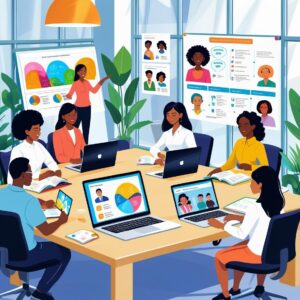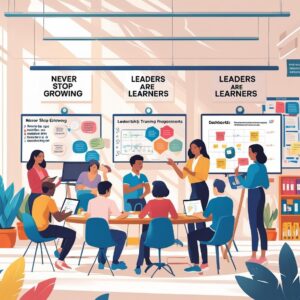When was the last time you and your team felt genuinely excited about learning something new at work? Not the obligatory annual training or tedious webinar – but an opportunity that sparked curiosity, creativity, and enthusiasm?
In today’s rapidly evolving business landscape, thriving organizations don’t simply react to change; they anticipate it. They build an environment where continuous learning isn’t just encouraged – it’s deeply embedded into the culture.
Continuous learning is more than a periodic course or certification. It’s about nurturing an ongoing curiosity and adaptability that empowers employees to stay ahead of industry shifts, technological advancements, and market disruptions. Companies that embrace this mindset consistently report higher engagement, improved innovation, and sustained competitive advantage.
Let’s explore how you can cultivate such a culture, transforming learning from an occasional event into an everyday practice.
Continuous learning has become essential as businesses face accelerating change driven by technological advances, shifting market demands, and evolving customer expectations. Employees who regularly upgrade their skills can quickly adapt, fostering a culture of innovation and agility.
Organizations with continuous learning cultures not only attract top talent but also retain it by fulfilling their employees’ desire for personal and professional growth. Such companies see tangible benefits including enhanced productivity, greater employee satisfaction, and significantly lower turnover.
Additionally, continuous learning equips organizations to anticipate and respond proactively to market disruptions, ensuring sustained competitiveness and resilience in uncertain economic climates.
Identifying learning gaps doesn’t have to feel like a mechanical exercise. It’s really about tuning in closely to your team and understanding their daily challenges and seeing clearly where growth could help.
Talk regularly with employees about their experiences, ask genuine questions about their struggles, and actively listen to their feedback. Encourage honest self-assessments and foster a supportive environment where managers and employees can comfortably discuss performance openly.
This relational approach helps you pinpoint skill gaps naturally and authentically, paving the way for meaningful growth opportunities tailored specifically to your team’s real needs.
Creating a culture of continuous learning involves foundational elements that empower consistent growth. First, leaders must actively demonstrate their commitment by participating in learning activities themselves, setting a powerful example for employees.
Secondly, psychological safety is essential because employees must feel secure enough to experiment, take risks, and even fail without fear of negative consequences. Additionally, dedicating specific, structured time for learning ensures that professional development is prioritized rather than overlooked during daily routines.
Finally, leveraging social learning platforms, like internal communities and peer-sharing networks, enables collaboration and knowledge exchange, reinforcing a collective growth mindset across the organization.
Building a continuous learning culture involves navigating hurdles and demonstrating value. Let’s explore inspiring examples from real-world companies that vividly illustrate how continuous learning fuels innovation and success.
Leading companies illustrate vividly how continuous learning fuels innovation and success. Take Google’s famous “20% time,” where employees are encouraged to dedicate a fifth of their working hours to passion-driven projects unrelated to their regular duties. This approach led to groundbreaking innovations such as Gmail and Google Maps, showing the transformative power of dedicated time for creative exploration and skill-building.
Similarly, Microsoft adopted regular “learning days,” halting typical operations to allow employees focused time to explore new skills, technologies, and ideas. These structured, company-wide pauses for learning have boosted morale, enhanced employee retention, and sparked significant improvements in productivity and innovation.
LinkedIn offers another inspiring example: providing all employees unlimited access to LinkedIn Learning resources, facilitating a culture of curiosity, self-directed growth, and continuous professional development. These stories highlight how organizations that genuinely commit to continuous learning see tangible and lasting results.

Here are four insightful keys to cultivating a culture of continuous learning
Lead by example, not just instruction
Great learning cultures start at the top. Leaders who visibly commit to their own growth inspire teams to do the same. It’s not about simply recommending training; it’s about participating actively, openly sharing lessons learned, and demonstrating the genuine value of continuous personal and professional development.
Foster psychological safety and trust
Innovation flourishes where people feel safe to experiment, make mistakes, and openly discuss ideas without fear of judgment or criticism. Creating such an environment empowers your team to challenge the status quo confidently, continually exploring new possibilities without reservation.
Embed learning into daily life
True learning isn’t just an event. It’s a habit woven into everyday experiences. Create brief, meaningful moments for your team to grow naturally throughout their day, whether through insightful conversations, practical demonstrations, or quick exchanges of ideas. Let learning become second nature, as intuitive as breathing, so growth happens consistently and effortlessly.
Celebrate learning as a journey
Cultivate a culture where each step forward, no matter how small, is recognized and celebrated. Acknowledge efforts, applaud improvement, and highlight success stories openly. When continuous learning becomes something, your team looks forward to rather than something they endure, engagement and innovation naturally thrive.
A culture of continuous learning is not built overnight. It’s nurtured through intention, inclusion, and inspiration. It begins when leaders stop treating learning as a side activity and start modelling it as a daily rhythm.
It grows when teams feel safe enough to ask questions, share failures, and try again. And it thrives when every small effort to grow is acknowledged and encouraged. Whether you’re starting from scratch or strengthening what already exists, remember this: learning is the heartbeat of a resilient, future-ready organization.
So, keep asking, keep evolving, and keep the learning alive because that’s where real transformation begins. When learning becomes a way of being rather than a box to tick, your organization doesn’t just survive; it thrives.
Start small, stay consistent, and above all, lead with curiosity. Because in the journey of growth, it’s not about how much you know; it’s about how willing you are to keep learning.

Are you ready for TRANSFORMATION? Dzigbordi Kwaku-Dosoo is a Ghanaian multi-disciplinary Business Leader, Entrepreneur, Consultant, Certified High-Performance Coach (CHPC™) and global Speaker.
She is the Founder and CEO of The DCG Consulting Group.
She is the trusted coach to top executives, managers, teams, and entrepreneurs helping them reach their highest level of performance through the integration of technical skills with human (soft)skills for personal development and professional growth, a recipe for
success she has perfected over the years. Her coaching, seminars and training has helped many organizations and individuals to transform their image and impact, elevate their engagement and establish networks leading to improved and inspired teams, growth and productivity.










